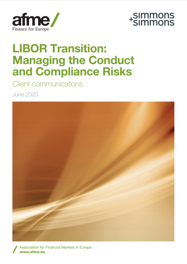On 25 June, AFME and Simmons & Simmons hosted our second panel/webinar with the Financial Conduct Authority (FCA) discussing LIBOR conduct and compliance risks. This session focussed on client communications.
First, the implications of the UK Government’s decision to enhance the FCA’s powers under the Benchmark Regulation were discussed. Although this decision will be significant in helping to ensure an orderly wind-down of critical benchmarks such as LIBOR, the FCA emphasised that industry participants should remain focused on active transition (of which client communications plays a big part), urging the industry “Please don’t take your foot off the gas, this remains a priority”.
On the topic of Covid-19, it was appreciated that it has had an impact on the interim transition timelines for firms and clients. The FCA understands the short to medium-term challenges faced by firms and delays to some aspects of transition caused by the pandemic, and have been operating with pragmatism during this period. However, the FCA noted that communications will need to be ready for when the time is right for clients and importantly, that the deadline that firms cannot rely on LIBOR beyond end 2021 for LIBOR [MR1] remains the same. In fact, the FCA emphasised that client communication strategies may need to be accelerated, particularly if they were due to have been progressed earlier in the year, and firms should expect supervisory engagement in this regard.
Panellists noted that the impact of Covid-19 on communications has varied depending on the client segment. For instance, some firms might be more likely to continue having conversations with large corporate clients, but conversations with SME clients might have been delayed. This slowdown has also impacted the roll-out of alternative rate products and consequently the build-up of liquidity in the alterative rate market.
However, despite the slowdown, it was acknowledged that in recent weeks there have been positive signs of progress. As with Covid-19 communications, a tailored approach across client segments and product lines is important, but flexibility should also be built into communication strategies to allow for market developments and client needs evolving over time. Understanding the client base will be key to effective communication on LIBOR transition and this will involve gaining as full a picture as possible of clients’ exposures. Firms could consider a number of factors when devising communication strategies:
- Knowledge, understanding and experience of the intended audience. E.g. large corporate clients compared with retail mortgage holders.
- The type of product. E.g. Different contracts and currency might have varying levels of complexity when being amended.
- The geographic location of the customer and any market-specific considerations. E.g. some markets do not have a forward-looking term rate. Firms must also take cross-border rules into account when advising clients in different jurisdictions.
- Determining the most effective means of engaging with clients for different communications. E.g. Phone, email, website.
There was some discussion of the requirement to ensure that client communications are “clear, fair, and not misleading”.[1] The FCA noted that information should be presented in good time, to enable clients to make informed decisions. Additionally, for products referencing LIBOR which mature beyond 2021, firms will need to properly explain to clients what may happen to the rate and how the fallbacks operate. It was highlighted that the best way to avoid additional LIBOR-related conduct risks is to offer alternative products that do not reference LIBOR. However, it is important that wherever alternative options are presented for new products or to change existing products, firms will need to make sure they are reasonably presented, including their benefits, costs and risks.
Panellists agreed that communication strategies and the terminology used need to be considered, taking into account the level of sophistication of certain clients. For less sophisticated clients a balance should be struck between keeping communications as simple as possible, while not forgoing the use of important terminology when discussing the topic, which in itself could be confusing if firms switch to using different terms from those widely used in the market. For example, firms should consider whether the term ‘risk-free rate’ could be misunderstood (notwithstanding that it is a term which is widely used in some parts of the market / industry) and consider providing further context and detail. Panellists pointed to helpful resources such as the Factsheet published by the Working Group on Sterling Risk-Free Reference Rates, which can assist in client education.
In a similar vein, front office and supporting staff also need to be trained as staff need to build up their awareness and understanding of the implications of LIBOR transition for clients. Firms may wish to begin by educating all relevant staff on the topic in a broader context and then build on this with more tailored training dependent on the function (e.g. front office, legal, compliance). Training could be facilitated through various methods such as E-learning, webinars, or daily updates. For more specific training, and particularly where staff engage directly with clients, more classroom style- training where scenarios can be discussed may be most effective.
Finally, panellists discussed the need to monitor the effectiveness of their communication strategies. Communications should be measured against their intended purpose, for example firms could monitor whether information published on their website is getting the high footfall that might be expected for such a public medium. Firms should consider how they collect data on their communications in such a way that it can be aggregated for use as Management Information, both to inform the evolution of the strategy and to validate the work that the firm is undertaking. Panellists also discussed possible ways to record the client communications that have taken place, for example by using already existing record keeping systems and making adjustments where necessary for the purposes of LIBOR transition (whilst at the same time not introducing record keeping requirements which are inappropriate).
As proceedings drew to a close, the take-away message from panellists was that it is never too early to start LIBOR transition communications. While the deadline might seem far away, firms will need ample time to regularly update their staff and clients on what is a constantly evolving process. While acknowledging ‘first mover’ reluctance, there is a risk in waiting too long. Communication plans need to be detailed, dynamic and ramp-up as we move ever closer to the end-2021 deadline.
To read in more detail about the practical guidance for firms in their approach to client communications, read the full AFME and Simmons & Simmons paper.
Watch the webinar, click here

AFME Contacts
Richard Middleton
Managing Director, Head of Policy
+44 (0)20 3828 2709
Fiona Willis
Associate Director, Policy
+44 (0)20 3828 2739




